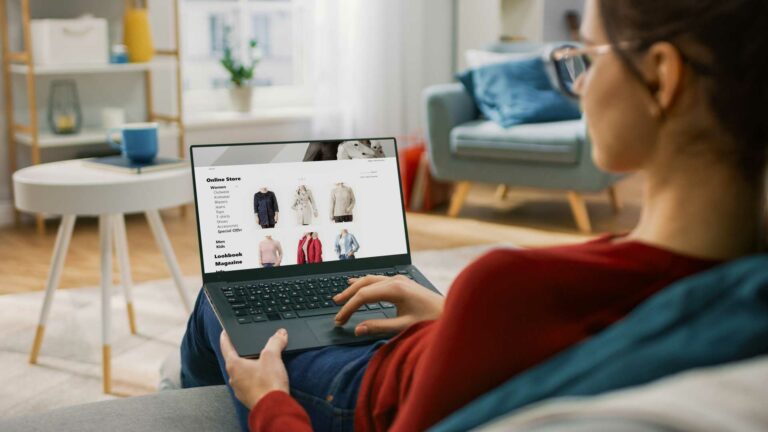Online shopping doesn’t have to mean a high number of returns
We are all aware that the COVID-19 pandemic has accelerated digital adoption for consumers and as a result, there has been a rise in brands going direct to consumer (D2C) and retailers upping their online shopping game.
According to the Office for National Statistics,
“The proportion of retail sales generated online hit a record high of 36% in January this year (2021).”
This growth is putting pressure on brands to improve their ecommerce propositions and online shopping experiences, ensuring their websites are robust and engaging enough to handle the increase in D2C demand. With this comes a desire from the consumer to create meaningful digital relationships with brands, often including interaction with real people using solutions that offer video live chat options and interactive product demonstrations.
Retail Week’s survey of 1000 consumers captured that,
“44% of consumers will continue to shop online as much as they did through lockdown despite stores re-opening”.
Considering this, managing online returns is a critical pressure point across all sectors. From consumer electronics to apparel, they all face similar challenges in returns management and how this impacts customer experience and loyalty. Consumer-friendly brands often feel obliged to accept what would usually be seen as an unacceptably high level of returns to retain business and win against fierce competition. Clearly, there is also a profound impact on sales revenues and profit margins and the way brands look to address the future of online shopping within their own business merits careful consideration.
According to estimates by buy-now, pay-later payment provider, Openpay, released in 2020:
“Items bought online and returned in the UK are worth £5.2bn annually”.
A McKinsey Returns Management Survey conducted just prior to the COVID-19 pandemic noted a,
“25 percent return rate for apparel on ecommerce channels, compared to 20 percent overall”.
Customer expectations on return management are higher than ever with a difficult return experience likely to lead to disengagement with an organisation.
“33 percent of repeat consumers would choose to abandon a retailer if they had a “difficult” returns experience”.
Many brands and retailers see high returns as a necessary evil to grow share of wallet, but most are not putting it high on their agenda to tackle.
“Managing returns is not among the top five priorities for a third of retailers”.
There is also an ethical consideration to returns as consumers become more waste conscious but alarmingly companies are disposing of damaged returns in landfill as they find it less expensive and logistically easier than working on a strategy to improve their return economics.
“37% said it is important that the brands they shop with show respect for the environment.”
Managing returns effectively is a complex matter with operational challenges, unclear cross-departmental ownership, reverse logistics inefficiencies and limited data to address root causes of returns.
However, companies can better serve customers by focusing on a few capability gaps and leveraging tools which help prevent returns and improve consumer experience.
When the McKinsey survey respondents were asked to assess the impact of advanced shopping tools to improve customer experience live chat assistance was comfortably placed amongst the tools considered as basics like sizing guides, fit comparisons, and customer reviews.
“Companies with a live chat assistant rated it 70% effective at reducing the rate of return”.
Considered review of data collected through digital interactions allows online sales assistants to quickly gain an understanding of the product details and challenges that are contributing to higher returns and be trained on how to specifically address any such concerns. Being able to show a potential customer exactly how a product operates, within a branded environment that has a professional and premium look and feel, all adds to customer confidence and builds purchase satisfaction.
There has also been excitement around ‘in-store clientelling’ tools to better recommend products based on the customer profile but this need not be limited to the physical environment.
Creating emotional connection commerce is key to delivering a powerful retail experience both physically and digitally. This, in turn, is likely to reduce returns as customer confidence builds in both their purchase decisions and their ability to get the very best experience from their chosen product when they begin to use it in their home or work environment.
Storey is a tool which connects brands to consumers through personalised online shopping experiences, powered by video, text and live chat. This real-time tool supports the entire customer journey, from research through to after sales support by providing a safe place to connect with a human to gain advice, recommendations and even demonstrate products.
“70 percent of returns were caused by poor fit or style.”
Precise returns data is often limited but the most stated reasons can be overcome during a live interaction. Providing detailed measurements to verify ‘true fit’, showcasing a product alongside potential accessories or being able to provide close-up views of fabric textures or colours over live video chat will all raise the bar on the online shopping experience.
Our digital experts report that 86% of shoppers return at least twice to ask questions during their purchase journey, jumping from online to physical retail and back again. Aiding the seamless transition between these environments is critical to meet customer expectations as they become more confident in shopping online and they expect to be met by brands in every location with the same standards and support available.
Video live chat and interactive product demonstration can also be a very effective way of ensuring that shoppers have everything they need when making a purchase decision. This use of what might be seen as conversational commerce helps the consumer get the right product and then enjoy the best experience with it. Ensuring the right “add-ons” go into the online basket, from cables to care plans, enhances the overall customer experience and therefore reduces the risk of dissatisfaction leading to return.
There will still be times when returns are unavoidable but the provision of live human contact during the process is more likely to lead to a repurchase or exchange due to the consultative opportunity, retaining some of the order value. Concerns can be addressed, questions answered, and recommendations made to alleviate fears of ‘getting it wrong’ again.
Based on Retail Week’s survey findings it is also clear that many consumers who have already adopted new behaviours and technological innovations will retain at least some of those new habits:
“40% of consumers said they will take advantage of online services launched during lockdown such as video product demonstrations and online consultation services, even after stores open”.
Consumers want personal shopping experiences online and they expect these experiences to be available 24/7 and with the right answer the first time. This is no mean feat to achieve but high levels of customer satisfaction following a live engagement with a brand will encourage loyalty, the holy grail in the world of ecommerce.
Ader, J et al (May 2021) McKinsey’s Retail and Consumer Packaged Goods Practices. https://www.mckinsey.com/industries/retail/our-insights/returning-to-order-improving-returns-management-for-apparel-companies
Harrison N et al (June 2021) The CX Factor. Retail Week – in Association with Manhattan Associates
monica




